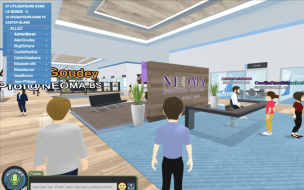Demand for AI content and programs at business school grew by 38% year-over-year, according the 2024 Prospective Student Survey from the Graduate Management Admission Council.
If you’re a business leader—or aspire to be one—understanding what AI means for your organization could open your eyes to new ways of working, managing, or even opportunities for new products. You’ll also need to understand the risks, however.
So what do business leaders need to know about AI right now?
At the recent Learning@INSEAD summit at the leading business school’s Fontainebleau campus in France, which offers a number of Executive Education programs in AI, two leading professors shared an overview of the fundamentals.
What is artificial intelligence?
“One simple way to think about it is to say that it’s a machine’s ability to perform some human cognitive tasks,” explained Villa Satopää, assistant professor of technology and operations management. “It is [also] a process that allows us to analyse massive amounts of data with the kind of rigor and in the quantity and with the speed that is not possible for human beings.”
What is AI currently used for?
Despite what the films may show us, we don’t have general AI yet—this is where you would have a robot that walks around your house learning how to tackle new problems or that has consciousness. Instead, according to Villa, what we mostly have is AI that is very powerful at crunching data to work on narrowly defined problems.
“The hype today is in an area called machine learning (ML),” he said. “You can think of it as statistical AI or where statistics meets computer science.”
Simply, ML means training computers to look at large sets of data and to ‘learn’ the rules from that data without being programmed. And when the machines recognize patterns in data—they can make predictions.
What is ChatGPT and how does it work?
ChatGPT is the most famous example of generative AI (gen AI). It uses machine learning (or ‘deep learning’) and is an application trained on vast amounts of data with billions or trillions of parameters, depending on the version you use. It basically works through prediction: you feed it a prompt (or question), and it gives you the best answer it can predict. However, ChatGPT like all gen AI, has flaws.
“What it will do is go one word at a time and predict what is the next most likely word that is going to come out. It fills in the blanks,” said Villa, who quotes estimates that around 20% of the information that ChatGPT publishes is inaccurate.
This is because it works by taking info indiscriminately from across the internet—which as we know, is not always verifiable and often filled with errors and bias.
Can ChatGPT or gen AI do human work?
Anyone who has used ChatGPT or other gen AI can see how quickly the technology can give impressive looking, neatly formatted answers to prompts. It can summarize documents at great speed or ideate creative ideas in seconds to save brainstorming time. But, argued Villa, you’ll always need a human to edit or check the answers gen AI provides.
“We should think about AI as a co-pilot not as an autopilot,” said Villa. “It's something that is there to be sort of secondary to you, but there to help you to lift you up to another level to be more efficient, or to enjoy your work more—to be able to delegate some really mundane, boring tasks to a machine that doesn't complain.”
These comments chime with a recent McKinsey report, which said that it’s “time for a generative AI (gen AI) reset”. Proving the value of tools like ChatGPT is “harder than expected”.
How are businesses using AI today?
Lots of companies have been spending big bucks employing data engineers to try to find opportunities for harnessing AI.
Professor Peter Zemsky, Eli Lilly Chaired Professor of Strategy at INSEAD, has been keeping a close eye on the emerging opportunities that AI offers for almost a decade.
At the INSEAD thought-leadership summit, he said that “there's almost no process activity in your company we can't imagine this technology potentially helping”. However, he added that the “challenge [is] of taking all of this amazing technology that's coming out and actually getting business value in your organisation”.
Even when a new AI tool or solution is created and rolled out for business use, he explained, there is also struggle to get employees to shift their long-used, tried and tested working practices.
The truth is, according to Peter, most companies aren’t getting a return on investment on AI investment yet.
“All of that excitement around machine learning in the last 10 years in most companies has led to what? A lot of costs for hirings. And yet, you know, the honest answer if you look at it is the typical company is not a Google and is not an Amazon and is not getting the returns.”
So what are the opportunities for using AI in non-tech companies?
Using gen AI for quick problem-solving, idea generation or data synthesis—through careful prompting—can be a hugely efficient time-saving exercise. There will still need to be a human checking the output, but to get a starting point using Gen AI can be a significant help.
Additionally, according to Peter, use of AI in learning and development (L&D) is a growing opportunity—for example using avatars or bots in role play for training and to elicit immediate feedback.
The biggest use of AI is the emergence of APIs (Application Programming Interfaces) which are rules and tools that support communication between software applications. Even outside tech companies, most industries should be able to reap benefits from such integrations.
Simple API examples might be real-time sales information feeding up through the supply chain, or restaurants automatically balancing customer ordering patterns with ingredient pricing to support menu design. Ecommerce businesses have great opportunities to make efficiencies through such work.
However, Villa and Peter were both keen to highlight the risks of AI usage, in areas like data management or bias in algorithms. While AI can see patterns at pace that are undetectable to humans, it also misses nuance, as was seen recently when Google had to suspend its Gemini chatbot due to its inaccurate historical image generation.
One thing that's clear is that business leaders can't afford to delegate all AI knowledge to their team. Currently, being knowledgeable enough so that you can decide where and when to invest in AI is a big question for today and tomorrow's business leaders.








